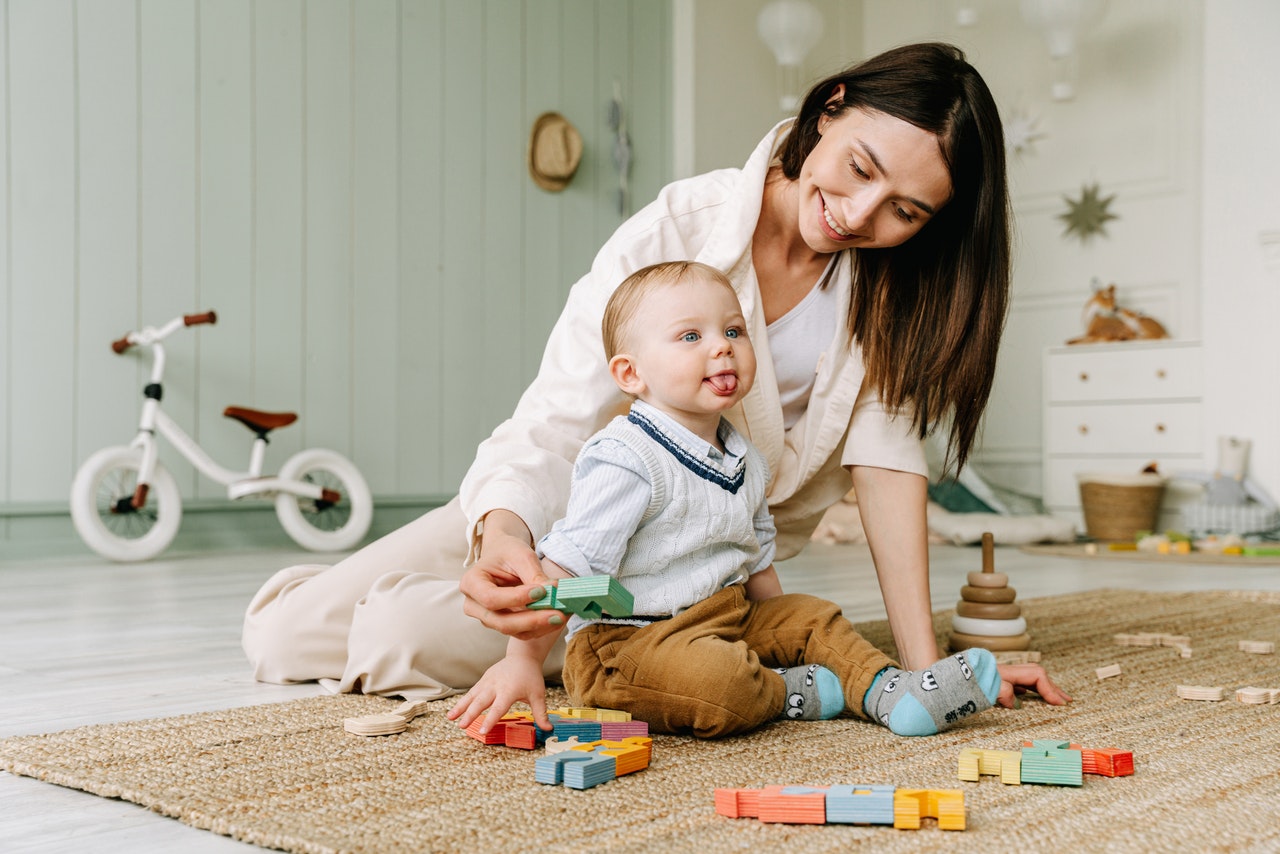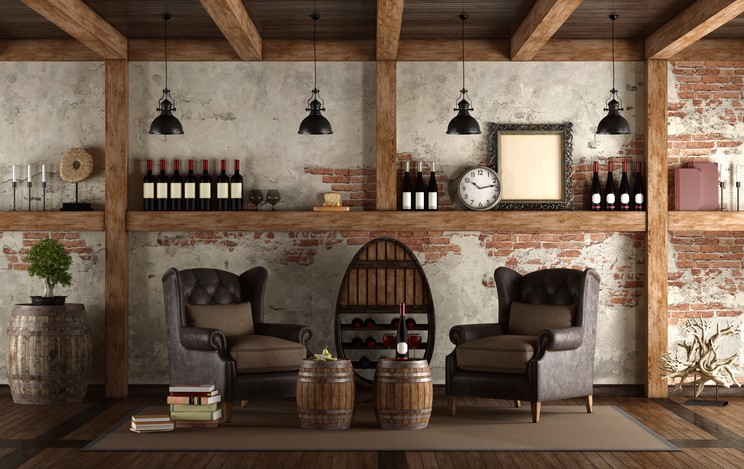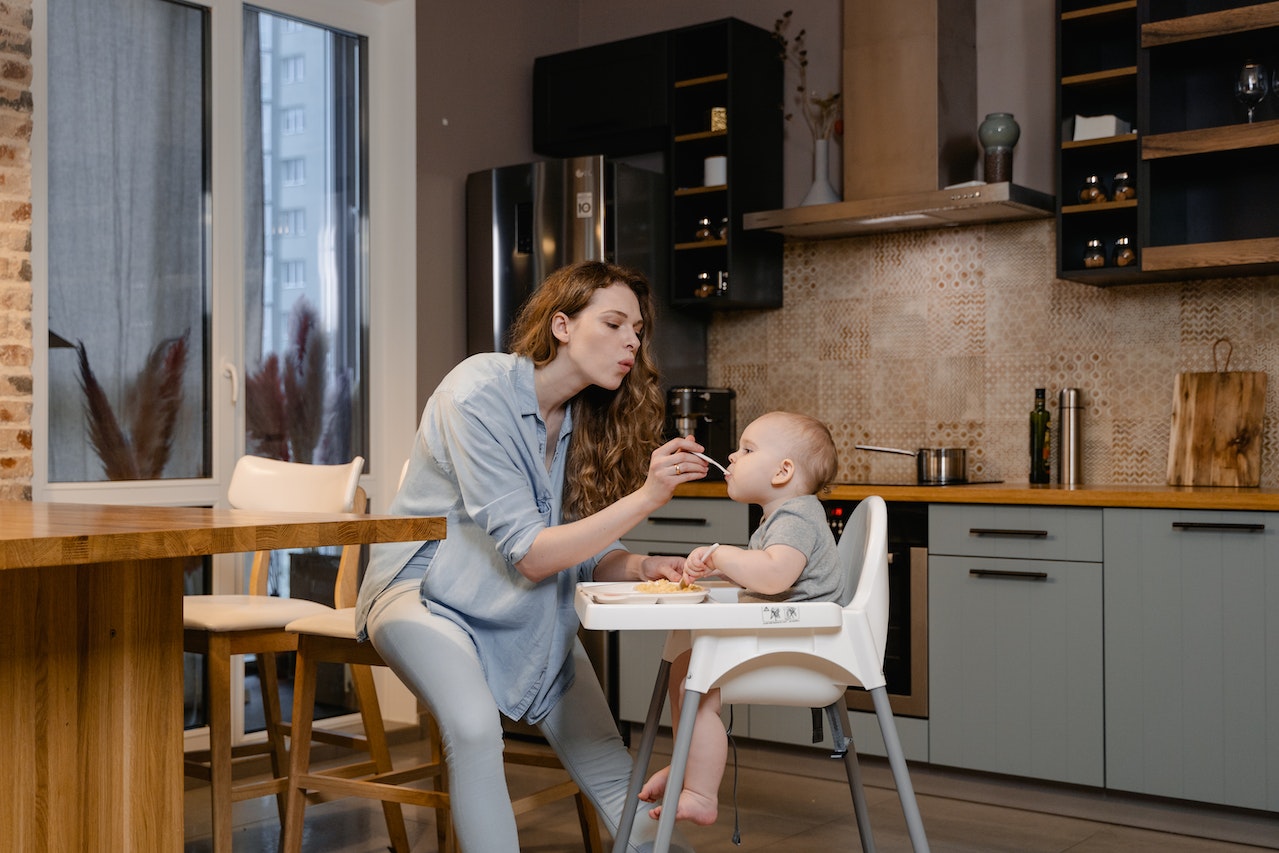From the moment of birth, babies start picking up information from their surroundings. Anything can be a stimulus: light, sound, movement, textures, colors, tastes, and so on.
Whether it’s with toys or without them, infants learn to move, talk, socialize, and understand their surroundings primarily through play. Your infant will learn by interacting with you during the first month of life. If you’re a parent or a parent to be, or if you plan to become one at some point, we believe you will find this article very helpful since every parent wants to see their children grow and learn while exploring the world.
We asked experts for their advice regarding promoting a baby’s skills development, setting up an indoor space or a playroom for this purpose, and what items are the best and the safest for children to interact with.
This is what they told us:
“What are the best options to set up a baby playroom on a budget? (up to $1K USD)“
Babies are precious! Every parent wants to make a special space for their charming baby. Setting up a baby playroom is easy to express your love and care for your little one. Babies need a unique place for motivation. Creating an exclusive area for the little ones can help them explore the new world easily.
An organized space helps babies to satisfy their curiosity and nurture active play. A colorful and bright playroom stimulates the baby’s playtime. Hence, creating a safe and amusing place for babies becomes essential.
5 Best options to set up a baby playroom on a budget
It’s not difficult to create a dedicated playroom for babies while your wallet remains happy. You can have plenty of options to set up a baby playroom on a budget. Here are some guidelines for building a comfortable place for your baby:
1 Get Baby-Safe Developmental Toys
Children need suitable toys to foster their creativity. Adding baby-safe developmental toys like shape sorter, baby gym, and activity walker to the baby play area creates a sense of safety and security in parents’ minds. It will help the baby play independently while you can sit relaxed without having to monitor your baby constantly.
2 Baby Play Mats
Younger babies are going to spend maximum time on the floor. Get a baby play mat or rug for the baby to play safely. Soft rugs or play mats can provide a clean and safe surface for the babies while they can enjoy their playtime on the floor.
3 Storage
You don’t want to have a messy playroom. Buy some storage boxes to organize the playroom. It will not only help the room to be mess-free but also helps your baby play without hurdles like toys and their parts.
4 Bookshelf
It’s a great idea to introduce books to babies from the beginning. You can decorate the playroom with a beautiful bookshelf that contains the baby’s first books. You can get several soft-touch books that are safe and non-tearable.
5 A Nap Corner
If you don’t want separate rooms for playtime and naptime, you can create a nap corner in the playroom. Set it up with soft bedding and hang some baby mobile above it. It will not only help her get a relaxing nap but also helps her play after waking up.
You can find all of these items online at a very affordable price tag in mainstream online stores like Amazon, Etsy & Pottery Barn Kids.
Supriya Gujar Mehta
“What are the main characteristics a Baby Play Mat should have to ensure the baby’s safety?”
When choosing a baby play mat, safety should be your number one priority. There are a few key characteristics to look for in a safe play mat:
Materials: Look for a mat made from safe, non-toxic materials. Baby skin is delicate, so you want to make sure the mat is made from materials that won’t irritate or cause any harm.
Thickness: A safe play mat should be at least 1/2 inch thick. This will provide enough cushioning in case your baby falls or rolls off the mat.
Stability: Look for a baby play mat that is stable and won’t slide around on the floor. This will help prevent your baby from getting injured if they roll off the mat.
Size: Make sure the baby play mat is big enough to accommodate your child’s size. You don’t want them to outgrow the mat too quickly. The mat should be big enough to provide plenty of space for your baby to move around, but not so big that they could get lost in it.
Padding: The mat should have enough padding to protect your baby from any bumps or falls. It should be firm enough to provide a stable surface for your baby to play on, but not too hard that it might hurt them if they fall.
Easy to Clean: Look for a mat that is easy to clean in case of any accidents. Baby mats can get messy, so you want one that you can easily wipe down or wash.
By keeping these safety characteristics in mind, you can choose a baby play mat that will help your little one stay safe while they play.
Do your research and purchase from trusted brands with good reviews. A brand with a good quality play mat will be more than happy to provide a lot of information about their product and its safety features, so don’t be shy in asking!
James Donaldson
“What would you recommend to include in the design of a baby nursery to help stimulate the baby’s sensory development?”
There are many amazing activities to stimulate the baby’s sensory development and you can find many ways to help with that when choosing items for your baby nursery. Attaching a mobile into the baby crib is great for visual and audio (if the mobile plays music) sensorial development and this activity is recommended for babies from 2 months old.
Another item you must include in your baby nursery is a shelf, since they are little babies until they are grown up, reading a book to your child is the best way to create a bond with them and stimulate listening and creativity! You can attach this shelf into the wall at a height that when your baby takes their first steps, he/she can pick up the favorite book and start a natural relation with reading for life. Don’t forget to select sensorial books, there are amazing books to develop touch with different fabrics. Also you can add to your shelf, teddy bears and other recommended toys to have more options when it is tummy time.
The usual changing diaper time can be also used to stimulate the baby’s sensory development. Talking to your baby, making different voices and playing peek a boo after changing diapers helps the visual and listening development of your baby. That’s why it is very important to have a safe changing table and all items close such as diapers, wipes and diapers cream at this moment.
Tip – always make sure all items in your baby nursery are tested and meet the US regulations for baby safety, also every toy or book chosen is ideal for your baby’s age.
Every moment is special and unique with your little one and can be used to stimulate your baby’s sensory development, use your creativity!
Luciana Nogara Loss
“What kind of activities help develop social-emotional abilities in a baby’s first years?”
In the first eighteen months, your baby has one big job and that’s to learn to trust the people in their world. When that happens, they’ll feel safe to explore, experiment and blast through the early years with confidence, joy and a strong foundation for social emotional development.
How can parents make this happen? Most importantly, by being responsive to their baby – every cry, coo, smile, frown or action is an invitation to engage. Your predictable, gentle responses give them a sense of safety, a basic need that must be met for your child to learn to trust.
Intentional activities that you can do include making eye contact, gentle touches, talking to them with lots of smiles and animation, getting on the floor with them to play, making funny faces, imitating each other, reading books with them on your lap, maintaining a predictable routine for meals, naps, and bedtime and singing to them. Simple toys and games allow you to connect too. Every baby loves peek-a-boo starting around 9 months and will love playing with you.
As you go about the everyday of diapering, feeding, getting dressed, make it a time for connection through conversation and gentle touch. When you speak and they respond, you support their language development, which begins long before they speak their first word. The back and forth cooing sounds you make with each other are their first conversations!
A sensitive, responsive parent who maintains a positive, loving emotional connection with their child is exactly what they need to learn to trust their world. When they trust you, attachment happens. This trust and attachment, that needs to happen in the first eighteen months, is the foundation of social emotional development. And believe it or not, it’s an indicator of the success of future intimate relationships.
So talk to, hug, play with, love on, observe and be there for your baby. Don’t worry about all the “stuff”. They really just want you.
Ann McKitrick, MS
Early Childhood Specialist & Parenting Coach
“What activities would you recommend to stimulate the development of a baby in the ages of: half-year-old, one-year-old, 1-2 years old, and 2-3 years?
6 Month Old:
- Make a sensory basket for your baby with items to explore. Add in objects with different textures and sizes. Easy items to add in would be soft balls, board books, silicone utensils, wash cloths, or blocks. Talk about the item’s size, shape, and texture with your baby to build vocabulary.
- Put some whole milk yogurt on a cookie sheet for your baby to smear around. This is edible and such a fun sensory experience for babies.
1 Year Old:
- Ice cube painting using an ice cube tray or baby food freezer tray. Add in some water and food coloring to the tray. Make a handle using popsicle sticks or Mega blocks. Freeze until solid and they can paint!
- Make your own edible paint with yogurt and food coloring. Put some plain yogurt into a muffin tin and add in food coloring to make different colors. Let them use their hands to paint or use paint brushes.
1-2 Year Old:
- Playdough is a fun activity and great for fine motor skills. Add in some wooden blocks so they can build with the playdough and learn early math skills.
- Taste safe sensory bins are good for 1-2 year olds. My favorite sensory bin for this age is ice and water. Add some ice and water to a small underbed storage tub. Put in utensils, measuring cups, bowls, etc. for your child to play with. You can dye the water with food coloring for extra fun!
2-3 Year Old:
- Put shaving cream on a cookie sheet or table. They can smear it around or practice letters or numbers.
- Make a nature cutting bin. Add in non-toxic leaves, small twigs, or flowers to a tub and have your toddler cut them.
- Have your toddler string beads onto a pipe cleaner. It’s a good activity for fine motor, concentration, and creativity.
Amy Sutliff
“What activities boost both baby’s sleep and brain stimulation best, and what’s the best way to adequate a space for this purposes?”
In the first three years of life, our babies’ brains are developing at an absolutely astounding rate. It’s estimated babies gain more than a million neural connections every second, and providing stimulation encourages and strengthens those connections, which can have a tremendous impact on how they learn and interact with others later in life.
Additionally, babies need sleep, a lot of sleep, to solidify and organize those connections, so here are a few tips on striking the right balance between stimulating and relaxing activities.
- When we’re talking about infants, there are obviously a limited number of stimulating activities that they can engage in, but not to worry. What may seem mundane to you is actually very stimulating to an infant! Feeding, holding, bathing and even changing diapers actually provide a tremendous amount of stimulation for a newborn.
- Babies are amazingly adept at associating spaces with activities, so having a designated area that’s just for playtime can help them anticipate some stimulating activities and respond accordingly. Try not to keep toys around the areas of the house where you like to feed/nurse in order to avoid distractions.
- Keeping the nursery dedicated entirely to sleep works the same way. Once they enter the room, they know it’s time for sleep, and their bodies will respond accordingly, beginning the release of melatonin, relaxing the muscles, and slowing down brain activity for a nice, rejuvenating snooze.
- Babies of all ages love to take in new sights, sounds and smells, which means that taking them for walks outdoors is one of the best ways to provide constant stimulation. Exposure to indirect sunlight also stimulates melatonin production, which will help baby sleep better at bedtime.
- Be sure to schedule your baby’s activities appropriately. We want to avoid stimulation before baby goes to sleep, whether it’s for the night or just for a nap, so whatever fun activities you plan to engage in, try to schedule them shortly after your baby wakes up. Turning down the lights and turning off the screens an hour before sleep will also help the body and brain relax and prepare for rest.
Dana Obleman
Founder & Creator of the Sleep Sense Program
“What would you say are the most common hazards to avoid (in a playroom) when playing with a baby?”
Stimulating your baby’s senses is important for developing their curiosity, and creative thinking while also creating new neural pathways in their brain’s development. However, we also need to ensure that our baby’s play area is a safe area. One of the most common hazards to avoid in the playroom is placing your baby unattended on a high surface. Many parents put their baby in a bouncer or playmat and place these on top of a table or benchtop. However, we can never predict how early our baby might start rolling over or reaching for objects, which can lead to a baby falling from a dangerous height.
Another important safety factor to ensure is that crawling babies cannot access hazardous items. This includes removing items from your baby’s crawl space, such as dog food bowls, handbags, or nappy bags, and any toys that are small and are a potential choking hazard. Placing child safety latches on cupboards with dangerous chemicals such as cleaning products and medicines will also ensure your baby can’t ingest anything harmful.
Lastly, as parents, we need to ensure that our baby is comfortable and feels safe to actively explore when they are in their play area. We always recommend including a padded play mat in the baby’s playroom to provide a safe crash landing pad when they are learning to pull themselves up and walk. It is also important to ensure that there are no sharp objects or corners in their play area. Foam edge protectors can be placed over the sharp corners of items such as cabinets and shelves to prevent any dangerous knocks. Baby’s also like to pull themselves up and climb on things. This is part of developing their gross motor skills and coordination and is part of exploratory play. For this reason, heavy items such as drawers and cupboards should also be bolted to the walls of the playroom so that the baby can’t pull them over onto themselves.
Sarah James
Psychology Teacher and owner of The Sensory Specialist
“Why is movement important for a baby’s development, and what can I do if my baby is more a calm type than a ‘mover’?”
Your baby is learning to move from the moment they are born. Movement lays the foundation for their success and processing development. Every movement your baby makes compounds cognitive and physical development.
Some babies seem to be calm or laid back, and might not move much. During their first weeks and months of life, your baby needs stimulation for crucial foundations as they are learning to initiate skills needed for current and future milestones.
Tummy Time
Immediately after they are born, your baby should be content in tummy time. They should be able to go in and out of sleeping and moving during this important milestone. One way you can enjoy tummy time is with you! Gently lie back and place your baby on your chest. While holding your baby, gently rock with your baby as if you are slow dancing. Talk and sing to them as they hear your voice through their ears and belly. This is the perfect way to experience tummy time, especially for a baby with colic or reflux. Remember, all babies need to be supervised during tummy time.
Swaddling
Swaddling your baby is a very common process as you are taught this is the best solution to calm your baby and give them a ‘womb’ like experience. But guess what?! They are out of the womb. Yes, your baby will sudden startle, but they are learning a valuable lesson, how to oppose gravity or the floor. If you are practicing
swaddling, you need to also practice un-swaddling. As your baby is content, place your hands under their pelvis. Gently sway they bums to the right and to the left. Don’t move more than a 1/2 inch (2 cm) as you give them the sensation of true movements. As you get into a little rhythm, slowly move up the spine (the back), as your baby will slowly start to ‘stretch’ out of their blanket. What are they learning? How to go past an object to self-sooth through movement. Any baby should be able to sleep without a blanket. Whether in your arms or in the crib, their lungs, spines, head and pelvis are learning to breathe, move, and learn.
What are some key warning signs with a calm baby?
• Sleeping through feeds.
Is it time to nurse or bottle-feed your baby, and they seem to be non-responsive or hard to wake. A new parent is quick to brag that their baby is ‘sleeping’ through the night. This typically doesn’t happen until they are a few months old. If you feel your baby doesn’t eat enough or soil the proper amount of diapers, let your pediatrician know.
• Is your baby a light crier?
Is it hard to hear your baby from the next room? Do they seem not to cry if they are hungry or wet? There can be a difference from a passive baby to a non-responsive baby. Video your child’s cry so their doctor can make an assessment
• Do they seem to look through you?
Your baby has no purposeful vision until they are going into their first month. They will start to attempt to focus and look. As their vision is very short, this makes their favorite thing to look at is you! Do they seem to look through you? Take a solid color ball and let them try to ‘focus’ on the object. Stay away from a large, multi-colored or black and white object. Also, no phone or iPad apps. Gadgets have too much strobing, and babies lack depth perception during their early months.
Remember, if you have any concerns about your baby’s progress or physical development, get help through your pediatrician. At the same time, continue with movements for your baby’s milestone momentum.
The best gift you can give your child is movement. As you are getting to know your precious newborn, enjoy the bonding time with gentle movements.
Michelle Turner
“What are the pros and cons of incorporating tech gadgets into babies’ playtime, to support their motor, cognitive, and sensory skills development?”
In this day and age, it’s hard to imagine living without tech gadgets. We rely on them for so many things – from communicating with others to getting our work done. And now, these gadgets have made their way into our babies’ lives! For instance, there are now apps and games designed specifically for babies, which can be played on a tablet or smartphone.
While this may seem like a great way to keep your little one entertained, you might be wondering – is it beneficial for their development? Let’s look at the pros and cons of incorporating tech gadgets into babies’ playtime.
Pros of Incorporating Tech Gadgets Into Babies’ Playtime
Some experts believe that tech gadgets can help support babies’ development in several ways. For example, tech gadgets can:
Help Babies Learn Cause and Effect
When babies press buttons or swipe screens, they see that their actions result in something happening. This helps them understand cause-and-effect relationships, which is an essential part of their cognitive development.
Support Sensory Development
Babies’ brains are constantly growing and making connections as they absorb new information through their senses. Tech gadgets can provide babies with various stimulating visual, auditory, and tactile sensations that can help support their sensory development.
Cons of Incorporating Tech Gadgets Into Babies’ Playtime
Despite the pros of incorporating tech gadgets into babies’ playtime, there are also some potential drawbacks to consider. After all, tech gadgets:
Limit Physical Activity
One of the potential drawbacks of tech gadgets is that they can limit physical activity. For example, if a baby is sitting in front of a flatscreen playing with an app, they are not getting the opportunity to move around and explore their environment.
Create Dependence
Another potential drawback of tech gadgets is that they can create dependence. Babies may become reliant on tech gadgets to entertain them and may have difficulty playing without them.
So, while there are some potential benefits to incorporating tech gadgets into babies’ playtime, there are also some potential drawbacks to consider. Ultimately, it is up to parents to decide whether or not they want to incorporate tech gadgets into their babies’ playtime.
Casanova Brooks




